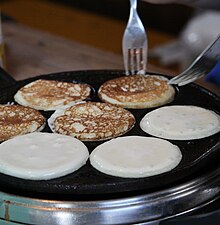Dalken
Dalken or Dalkerln ( Czech Vdolek , plural vdolky or Lívanec , Pl. LIVANCE ) are a traditional pastry of Czech cuisine and among the pastries . Dalken be in a special pan with half round or flat depressions on the hearth in fat, usually lard , baked. Traditionally, yeast dough ( yeast dough) is used. Dalken can be coated with powidl (plum jam) or a mixture of poppy seeds , sugar and cinnamon .
Variations
There is also preparation with a thick pancake batter to which cream (sweet cream) has been added instead of milk. The dalken are served with a three-fruit jam made from raspberries, currants and gooseberries. To do this, put two dalks with jam together, sprinkle them with sugar and serve them warm.
Origin of name
The Bohemian Dalken get their name from the Czech word "vdolky" (= small hollow), which refers to the special pan shape with the trough-like recesses for baking the Dalken.
distribution
Dalken are popular not only in the Czech Republic , but also in Austria and Bavaria . In Austria and Bavaria they are sometimes also called Liwanzen , Liwanzln or Riwanzerln (from Czech Lívance ). In the 19th century they were also prepared in a special pan on the stove in many German households. Dalken pans were placed directly over the embers of the stove after removing the inner rings. Dalken pans from this time are still today on many flea markets, for example. B. to buy in Munich or Berlin . In Berlin, the Dalken went out of fashion when the cooking machines were removed from their apartments. Today you can buy pans with a smooth bottom, also for use on electric stoves.
The well-known Austrian chef Ewald Plachutta gives a recipe for Bohemian Dalken made from yeast dough , under which he lifts stiff egg whites and then lets it rest for 30 minutes. The dalks are then slowly baked in lard or butter in the recesses of the dalken pan on the stove and then coated with powidl ( plum jam ) and possibly dusted with icing sugar or other sugar.
The Schleswig-Holstein forts are also baked in a pan with indentations; Poffertjes are a Dutch variant.
Individual evidence
- ^ A b Heinz Dieter Pohl : The Austrian kitchen language. A lexicon of typical Austrian culinary specialties (with linguistic explanations) . Praesens-Verlag, Vienna 2007, ISBN 3-7069-0452-7 , ( Studia interdisciplinaria Ænipontana 11), article Dalken and Liwanzen
- ↑ a b Ewald Plachutta / Christoph Wagner, The best from the Austrian cookbook of the century, 1997, recipe for Bohemian Dalken, p. 351 f.
- ↑ Hannes Etzlstorfer (ed.); Kitchen art & table culture. Culinaria from antiquity to the present. Christian Brandstätter Verlag

